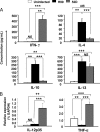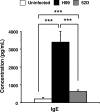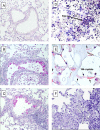Th2 but not Th1 immune bias results in altered lung functions in a murine model of pulmonary Cryptococcus neoformans infection
- PMID: 19752036
- PMCID: PMC2786439
- DOI: 10.1128/IAI.00809-09
Th2 but not Th1 immune bias results in altered lung functions in a murine model of pulmonary Cryptococcus neoformans infection
Abstract
Changes in airway dynamics have been reported in the rat model of pulmonary cryptococcosis. However, it is not known if Cryptococcus neoformans-induced changes in lung functions are related to the immunophenotype that develops in response to cryptococcal infection in the lungs. In this study we performed a parallel analysis of the immunophenotype and airway resistance (standard resistance of the airways [SRAW]) in BALB/c mice infected with highly virulent C. neoformans strain H99 and moderately virulent strain 52D. H99 infection evoked a Th2 response and was associated with increased SRAW, while the SRAW for 52D infection, which resulted in a predominantly Th1-skewed response, did not differ from the SRAW for uninfected mice. We found that an altered SRAW in mice did not positively or negatively correlate with the pulmonary fungal burden, the magnitude of inflammatory response, the numbers of T cells, eosinophils or eosinophil subsets, neutrophils, or monocytes/macrophages, or the levels of cytokines (interleukin-4 [IL-4], IL-10, gamma interferon, or IL-13) produced by lung leukocytes. However, the level of a systemic Th2 marker, serum immunoglobulin E (IgE), correlated significantly with SRAW, indicating that the changes in lung functions were proportional to the level of Th2 skewing in this model. These data also imply that IgE may contribute to the altered SRAW observed in H99-infected mice. Lung histological analysis revealed severe allergic bronchopulmonary mycosis pathology in H99-infected mice and evidence of protective responses in 52D-infected mice with well-marginalized lesions. Taken together, the data show that C. neoformans can significantly affect airflow physiology, particularly in the context of a Th2 immune response with possible involvement of IgE as an important factor.
Figures








References
-
- Arora, S., Y. Hernandez, J. R. Erb-Downward, R. A. McDonald, G. B. Toews, and G. B. Huffnagle. 2005. Role of IFN-gamma in regulating T2 immunity and the development of alternatively activated macrophages during allergic bronchopulmonary mycosis. J. Immunol. 174:6346-6356. - PubMed
-
- Barnes, P. J. 2000. Anti-IgE therapy in asthma: rationale and therapeutic potential. Int. Arch. Allergy Immunol. 123:196-204. - PubMed
Publication types
MeSH terms
Substances
Grants and funding
LinkOut - more resources
Full Text Sources

